Dersim rebellion
The Dersim rebellion (Turkish: Dersim İsyanı, Kurdish: Serhildana Dêrsimê) was an Alevi Kurdish[6][7][8][9][10] uprising against the Turkish government in the Dersim region of eastern Turkey, which includes parts of Tunceli Province, Elazığ Province, and Bingöl Province.[11] The rebellion was led by Seyid Riza, a chieftain of the Abasan tribe.[12] As a result of the Turkish Armed Forces campaign in 1937 and 1938 against the rebellion and its massacres of civilians, thousands of Alevi Zazas[6][13] died and many others were internally displaced.
| Dersim rebellion | |||||||
|---|---|---|---|---|---|---|---|
| Part of Kurdish rebellions | |||||||
.jpg.webp) Mustafa Kemal Atatürk and Sabiha Gökçen (November 17, 1937, in front of the Pertek People's House) | |||||||
| |||||||
| Belligerents | |||||||
|
| Dersim tribes | ||||||
| Commanders and leaders | |||||||
|
|
Seyid Riza (POW) Kamer Agha (Yusufan) Cebrail Agha (Demenan) Kamer Agha (Haydaran) | ||||||
| Strength | |||||||
| 50,000[2] | 6,000[3][4] | ||||||
| Casualties and losses | |||||||
| |||||||
On 23 November 2011, Turkish prime minister Recep Tayyip Erdoğan gave an apology for the Dersim massacre, describing it as "one of the most tragic events of our near history" adding that, whilst some sought to justify it as a legitimate response to events on the ground, it was in reality "an operation which was planned step by step". However, this is viewed with suspicion by some, "who see it as an opportunistic move against the main opposition party, the secular CHP."[14]
Background
Ottoman period
Kurdish and Zaza tribes, which were feudal (manorial) communities led by chieftains (agha) during the Ottoman period, enjoyed a certain degree of freedom within the boundaries of the manors owned by the aghas. Local authority in these small manorial communities was in the hands of feudal lords, tribal chieftains and other dignitaries, who owned the land and ruled over the peasants who lived and worked in their real estate.[17] However, the general political authority in the provinces, such as Dersim, was in the hands of the Ottoman government.
Early republican era
Following the establishment of the Republic of Turkey in 1923, some Kurdish and Zaza tribes became unhappy about certain aspects of Atatürk's Reforms for modernising Turkey, such as secularism[18] and land reform,[19] and staged armed revolts that were put down by the Turkish military.
Dersim had been a particularly difficult province for the Ottoman government to control, with 11 different armed rebellions between 1876 and 1923.[20][21] The rebellious stance of the aghas in Dersim continued during the early years of the Republic of Turkey. Aghas in Dersim objected to losing authority in their manorial affairs and refused to pay taxes; and complaints from the provincial governors in Dersim were sent to the central government in Ankara,[22] which favoured land reform and direct control over the country's farmlands, as well as state planning for agricultural production.[19] In an Interior Ministry report in 1926, it was considered necessary to use force against the aghas of Dersim.[23] On November 1, 1936, during a speech in parliament, Atatürk described Dersim as Turkey's most important interior problem.[24]
Resettlement Law
The Turkification process began with the 1934 Turkish Resettlement Law.[25] Its measures included the forced relocation of people within Turkey, with the aim of promoting cultural homogeneity. In 1935, the Tunceli Law was passed to apply the Resettlement Law to the newly-named region of Tunceli, previously known as Dersim and populated by Kurdish and Zaza Alevis.[26] This area had a reputation for being rebellious, having been the scene of eleven separate periods of armed conflict over the previous 40 years.[20][21]
"Tunceli" law
The Dersim region included the Tunceli Province whose name was changed from Dersim to Tunceli with the "Law on Administration of the Tunceli Province" (Tunceli Vilayetinin İdaresi Hakkında Kanun), no. 2884 of 25 December 1935[27] on January 4, 1936.[28]
Fourth General Inspectorate
In order to consolidate its authority in the process of Turkification of religious and ethnic minorities,[29][30] the Turkish Grand National Assembly passed Law No. 1164 on 25 June 1927[31] which allowed the state to establish Inspectorates-General.[32] Following the First Inspectorate-General (1 January 1928, Diyarbakır Province),[33] the Second Inspectorate-General (19 February 1934, Edirne Province)[11] and the Third Inspectorate-General (25 August 1935, Erzurum Province),[34][35] the Fourth Inspectorate-General (Dördüncü Umumi Müfettişlik) was established in January 1936, in the traditional Dersim region, which includes Tunceli Province, Elazığ Province and Bingöl Province.[36] The Fourth Inspectorate-General was governed by a "Governor Commander" within a military authority. He was given wide-ranging authority in juridical, military and civilian matters. He also had the power to resettle or exile people who lived in the city.[32]
On 1 November 1936, during a speech in the Turkish Grand National Assembly, Atatürk described the situation in Dersim as Turkey's most important internal problem.[37]
The rebellion
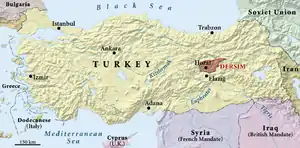
After the "Tunceli" Law, the Turkish military built observation posts in certain districts.
Following public meetings in January 1937, a letter of protest against the law was written to be sent to the local governor. According to Kurdish sources, the emissaries of the letter were arrested and executed. In May, a group of local people ambushed a police convoy in response.[38]
Meeting at Halbori cells
Seyid Riza, the chieftain of Yukarı Abbas Uşağı, sent his followers to the Haydaran, Demenan, Yusufan, and Kureyşan tribes to make an alliance.[39]
According to Turkish authorities, on March 20–21, 1937, at 23:00 hrs, the Demenan and Haydaran tribes broke a bridge connecting Pah and Kahmut in the Harçik Valley. The Inspector General gave the order to prepare for action to the 2nd Mobile Gendarmerie Battalion at Pülümür, the 3rd Mobile Gendarmerie Battalion at Pülür, the 9th Gendarmier Battalion at Mazkirt, and the Mobile Gendarmerie Regiment at Hozat, and sent one infantry company of the 9th Mobile Gendarmier Battalion to Pah.[39]
Turkish military operations

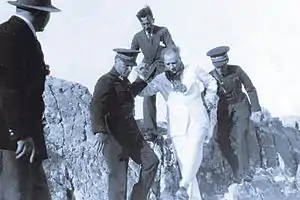
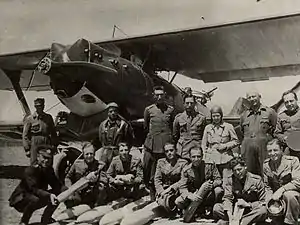
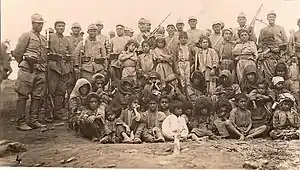
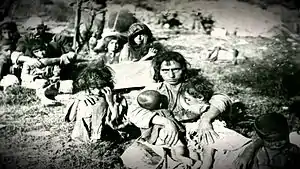
Around 25,000 troops were deployed to quell the rebellion. This task was substantially completed by the summer and the leaders of the rebellion, including tribal leader Seyid Riza were hanged. However, remnants of the rebel forces continued to resist and the number of troops in the region was doubled. The area was also bombed from the air.[20] The rebels continued to resist until the region was pacified in October 1938.[41]
According to Osman Pamukoğlu, a general in Turkish Army in the 1990s, Atatürk had given the operational order himself.[42]
First Tunceli Operation
On September 10–12, 1937, Seyit Rıza came to the government building of the Erzincan Province for peace talks and was arrested.[43] On the next day, he was transferred to the headquarters of the General Inspectorate at Elazığ and hanged with 6 (or 10) of his fellows on November 15–18, 1937[44] Ihsan Sabri Çağlayangil, who would later become foreign minister,[45] arranged the trials and hanging of the leaders of the rebellion and some of their sons.[46]
The victims were:
- Seyit Rıza
- Resik Hüseyin (Seyit Rıza's son, 16 years old)
- Seyit Hüseyin (the chieftain of Kureyşan-Seyhan tribe)
- Fındık Aga (Yusfanlı Kamer Aga's son)
- Hasan Aga (of the Demenan tribe, Cebrail Ağa's son)
- Hasan (a Kureyşan tribesman Ulkiye's son)
- Ali Aga (Mirza Ali's son)
On November 17, 1937, Mustafa Kemal Atatürk came to Pertek to take part in the opening ceremony for the Singeç Bridge.[47][48]
Second Tunceli Operation
The prime minister, Celal Bayar (in office: October 25, 1937 – January 25, 1939) had agreed to an attack on the Dersim rebels.[49] The operation started on January 2, 1938 and finished on August 7, 1938.
Third Tunceli Operation
The Third Tunceli Operation was carried out between August 10–17, 1938.
Sweep operations
Sweep operations that started on September 6, were continued for 17 days.[50]
Aerial operations
Turkish planes flew numerous sorties against the rebels during the rebellion. Among the pilots was Kemal Atatürk's adopted daughter, Sabiha Gökçen, the first Turkish female fighter pilot. A report of the General Staff mentioned the "serious damage" that had been caused by her 50 kg bomb, upon a group of fleeing bandits.[51]
Muhsin Batur, engaged in operations for about two months over Dersim, stated in his memoirs that he wanted to avoid talking about this part of his life.[52] Nuri Dersimi claimed that the Turkish air force bombed the district with poisonous gas in 1938.[53]
Civilian massacres
According to an official report of the Fourth General Ispectorate, 13,160 civilians were killed by the Turkish Army and 11,818 people were taken into exile, depopulating the province.[54] According to a claim by Nuri Dersimi, many tribesmen were shot dead after surrendering, and women and children were locked into haysheds which were then set on fire.[55] According to McDowall, 40,000 people were killed.[2]
Hüseyin Aygün, a jurist author, wrote in his book Dersim 1938 and Obligatory Settlement:
- "The rebellion was clearly caused by provocation. It caused the most violent tortures that were ever seen in a rebellion in the Republican years. Those that didn't take place in the rebellion and the families of the rebels were also tortured."[56]
Numbers killed
The contemporary British estimate of the number of deaths was 40,000, although this number could be exaggerated.[20] It has been suggested that the total number of deaths may be 7,594,[26] over 10,000,[57] or over 13,000.[14] Around 3,000 people were forcibly deported from Dersim.[26]
Ethnocide
The policy of population resettlement under the 1934 Law on Resettlement was a key component of the turkification process that began to be implemented first with the Armenian genocide in 1915 as Turkey transitioned from a pluralistic, multi-ethnic society to a "unidimensional Turkish nation-state". Scholar İsmail Beşikçi has argued that the Turkish government actions in Dersim were genocide.[58] Martin van Bruinessen has argued that the actions of the government were not genocide, under international law, because they were not aimed at the extermination of a people, but at resettlement and suppression.[59] Van Bruinessen has instead talked of an ethnocide directed against the local language and identity.[60] According to Van Bruinessen, the 1934 law created "the legal framework for a policy of ethnocide." Dersim was one of the first territories where this policy was applied.[61]
In March 2011, a Turkish court ruled that the actions of the Turkish government in Dersim could not be considered genocide according to the law because they were not directed systematically against an ethnic group.[62]
Aftermath
Apology
On November 23, 2011, Prime Minister Recep Tayyip Erdogan apologized "on behalf of the state" over the killing of over 13,000 people during the rebellion.[63] His remarks were widely commented on both inside and outside Turkey.[64] His comments were pointedly directed at opposition leader Kemal Kılıçdaroğlu (who in fact is from Dersim). Erdogan reminded his audience that Kılıçdaroğlu's party, the CHP, had been in power at the time of the massacre, then the only political party in Turkey.[14] He described the massacre as "one of the most tragic events of our near history" saying that, whilst some sought to justify it as a legitimate response to events on the ground, it was in reality "an operation which was planned step by step".[65]
See also
References
- Nazmi Sevgen, Zazalar ve Kızılbaşlar: Coğrafya-Tarih-Hukuk-Folklor-Teogoni, Kalan Yayınları, Ağustos 1999, ISBN 975-8424-00-9, s. 12.
- David McDowall, A modern history of the Kurds, I.B.Tauris, 2002, ISBN 978-1-85043-416-0, p. 209.
- "Osman Pamukoğlu, Unutulanlar dışında yeni bir şey yok: Hakkari ve Kuzey Irak dağlarındaki askerler, Harmoni Yayıncılık, 2003, ISBN 975-6340-00-2, s. 16
- Faik Öztrak, 07.07.1939 National Assembly Speech, Dersim Information
- NTV Tarih, Aralık 2009, sayfa 59.
- Nazmi Sevgen, Zazalar ve Kızılbaşlar: Coğrafya-Tarih-Hukuk-Folklor-Teogoni, Kalan Yayınları, Ağustos 1999, ISBN 975-8424-00-9, s. 12.
- Sammali, Jacqueline (1995). Être Kurde, un délit?: portrait d'un peuple nié - Jacqueline Sammali - Google Livres. ISBN 9782738437723. Retrieved 2013-12-24.
- Cigerli, Sabri (1999). Les Kurdes et leur histoire - Sabri Cigerli - Google Livres. ISBN 9782738476623. Retrieved 2013-12-24.
- "Can Kurds rely on the Turkish state?". Weeklyzaman.com. 2011-10-14. Archived from the original on 2014-11-29. Retrieved 2013-12-24.
- "16. Turkey/Kurds (1922-present)". Uca.edu. Retrieved 2013-12-24.
- Birinci Genel Müfettişlik Bölgesi, Güney Doğu, İstanbul, p. 66, 194. (in Turkish)
- "Accueil - Sciences Po Violence de masse et Résistance - Réseau de recherche" (PDF). www.massviolence.org. Retrieved 13 August 2017.
- http://www.massviolence.org/Dersim-Massacre-1937-1938 (According to the organisation encyclopedia of mass violence, Dersim is a kurdish alevi province, and the massacre of turks were towards zaza speaking alevi kurds)
- "Turkey PM Erdogan apologises for 1930s Kurdish killings". BBC News. 23 November 2011. Retrieved 24 November 2011.
- Martin van Bruinessen, "Zaza, Alevi and Dersimi as Deliberately Embraced Ethnic Identities" in '"Aslını İnkar Eden Haramzadedir!" The Debate on the Ethnic Identity of The Kurdish Alevis' in Krisztina Kehl-Bodrogi, Barbara Kellner-Heinkele, Anke Otter-Beaujean, Syncretistic Religious Communities in the Near East: Collected Papers of the International Symposium "Alevism in Turkey and Comparable Sycretistic Religious Communities in the Near East in the Past and Present" Berlin, 14-17 April 1995, BRILL, 1997, ISBN 9789004108615, p. 13.
- Martin van Bruinessen, "Zaza, Alevi and Dersimi as Deliberately Embraced Ethnic Identities" in '"Aslını İnkar Eden Haramzadedir!" The Debate on the Ethnic Identity of The Kurdish Alevis', p. 14.
- Faik Bulut, Devletin Gözüyle Türkiye'de Kürt İsyanlar (Kurdish rebellions in Turkey, from the government point of view), Yön Yayınclık, 1991, 214-215. (in Turkish)
- Hassan, Mona (2017-01-10). Longing for the Lost Caliphate: A Transregional History. Princeton University Press. ISBN 978-1-4008-8371-4.
- Soner Çağaptay (2002). "Reconfiguring the Turkish nation in the 1930s". Nationalism and Ethnic Politics, 8:2. Yale University. 8 (2): 67–82. doi:10.1080/13537110208428662. S2CID 143855822.
- McDowall, David (2007). A Modern History of the Kurds. London: Tauris & Co. pp. 207–208.
- NTV Tarih, Issue: 11, "Dersim 1937-1938"
- Ziflioğlu, Vercihan (November 18, 2009). "Military documents to shine light on 'Dersim massacre'". Hurriyet Daily News. Retrieved 2010-09-22.
- Beşikçi, Ismail. (1990) Tunceli Kanunu (1935) ve Dersim Jenosidi (The 1935 law concerning Tunceli and the genocide of Dersim), Bonn, p.29. (in Turkish)
- Hasretyan, M. A. (1995) Türkiye'de Kürt Sorunu (1918-1940), Berlin, Wêşanên, ënstîtuya Kurdî: I.,p.262
- Çağaptay, Soner (2002). "Reconfiguring the Turkish nation in the 1930s" (PDF). Harvard. Retrieved 2010-08-02.
- Lundgren, Asa (2007). The unwelcome neighbour: Turkey's Kurdish policy. London: Tauris & Co. p. 44.
- New perspectives on Turkey, Issues 1-4, Simon's Rock of Bard College, 1999 p. 15.
- Paul J. White, Primitive rebels or revolutionary modernizers?: the Kurdish national movement in Turkey, Zed Books, 2000, ISBN 978-1-85649-822-7, p. 80.
- Üngör, Umut. "Young Turk social engineering : mass violence and the nation state in eastern Turkey, 1913- 1950" (PDF). University of Amsterdam. pp. 244–247. Retrieved 8 April 2020.
- Cemil Koçak, Umumi müfettişlikler (1927-1952), İletişim Yayınları, 2003, ISBN 978-975-05-0129-6, p. 144.
- "Üçüncü Umumi Müfettişliği'nin Kurulması ve III. Umumî Müfettiş Tahsin Uzer'in Bazı Önemli Faaliyetleri". Dergipark. p. 2. Retrieved 8 April 2020.
- Bayir, Derya (2016-04-22). Minorities and Nationalism in Turkish Law. Routledge. p. 139. ISBN 978-1-317-09579-8.
- Birinci Genel Müfettişlik Bölgesi, p. 66.
- Cumhuriyet, August 26, 1935.
- Erdal Aydoğan, "Üçüncü Umumi Müfettişliği'nin Kurulması ve III. Umumî Müfettiş Tahsin Uzer'in Bazı Önemli Faaliyetleri", Atatürk Yolu, Ankara Üniversitesi Türk İnkılâp Tarihi Enstitüsü, Vol. 33-34, pp. 1-14.
- Cagaptay, Soner (2 May 2006). Islam, Secularism and Nationalism in Modern Turkey: Who is a Turk?. Routledge. pp. 108–110. ISBN 978-1-134-17448-5.
- Hasretyan, M. A. (1995) Türkiye'de Kürt Sorunu (1918-1940), Berlin, Wêşanên, ënstîtuya Kurdî: I., p. 262. (in Turkish)
- Jwaideh, Wadie (2006). The Kurdish National Movement: Its Origins and Development. Syracuse University Press. p. 215.
- Faik Bulut, ibid, p. 221. (in Turkish)
- "'Dersim Katliamı'ndaki o fotoğrafın sırrı ortaya çıktı". Radikal. 23 December 2014. Retrieved 24 December 2014.
- Chaliand, Gerard (1993). A People without a country: the Kurds and Kurdistan. London: Olive Branch Press. pp. 58.
- "Pamukoğlu: Dersim'in emrini Atatürk verdi", Hürriyet, August 19, 2010. (in Turkish)
- Ahmet Kahraman, pp. 286-287. (in Turkish)
- Ahmet Kahraman, pp. 292-293. (in Turkish)
- "List of Former Ministers of Foreign Affairs". www.mfa.gov.tr. Retrieved 2020-07-22.
- Van Bruinessen, Martin (1994). Andreopoulos, George J. (ed.). Conceptual and historical dimensions of genocide. University of Pennsylvania Press. pp. 141–170.
- Cumhuriyet, November 18, 1937, 17 Kasım 1937: Atatürk'ün Diyarbakır'dan Elâzığ'a gelişi, Tunceli'nin Pertek kazasına geçerek Murat Nehri üzerinde Singeç Köprüsü'nü hizmete açışı. (in Turkish)
- "Atatürk Pertek'te" Archived 2010-07-27 at the Wayback Machine, The government of Pertek District. (in Turkish)
- "1937-1938’de Dersim’de neler oldu?" Archived 2010-05-22 at the Wayback Machine, Taraf, November 16, 2008. (in Turkish)
- Faik Bulut, ibid, p. 277. (in Turkish)
- Reşat Hallı, Türkiye Cumhuriyetinde Ayaklanmalar (1924–1938), T. C. Genelkurmay Baskanlığı Harp Tarihi Dairesi, 1972, p. 382. (in Turkish)
- Muhsin Batur, Anılar, Görüşler, Üç Dönemin Perde Arsası, Milliyet Yayınları, 1985, p. 25. (in Turkish)
- Martin van Bruinessen, Kurdish ethno-nationalism versus nation-building states: collected articles, Isis Press, 2000, ISBN 978-975-428-177-4, p. 116.
- "Resmi raporlarda Dersim katliamı: 13 bin kişi öldürüldü", Radikal, November 19, 2009. (in Turkish)
- "The Suppression of the Dersim Rebellion in Turkey (1937-38) Page 4" (PDF). Archived from the original (PDF) on 2013-05-21. Retrieved 2013-12-24.
- Hüseyin Aygün, Dersim 1938 ve zorunlu iskân: telgraflar, dilekçeler, mektuplar, Dipnot Yayınları, 2009, ISBN 978-975-9051-75-4, p. .
- Hans-Lukas Kieser: Some Remarks on Alevi Responses to the Missionaries in Eastern Anatolia (19th–20th cc.). In: Altruism and Imperialism. The Western Religious and Cultural Missionary Enterprise in the Middle East. Middle East Institute Conference: Bellagio Italien, August 2000
- İsmail Besikçi, Tunceli Kanunu (1935) ve Dersim Jenosidi, Belge Yayınları, 1990.
- Martin van Bruinessen: Genocide in Kurdistan? 1994, S. 141–170.
- The Suppression of the Dersim Rebellion in Turkey (1937-38) Archived 2016-01-08 at the Wayback Machine Excerpts from: Martin van Bruinessen, "Genocide in Kurdistan? The suppression of the Dersim rebellion in Turkey (1937-38) and the chemical war against the Iraqi Kurds (1988)", in: George J. Andreopoulos (ed), Conceptual and historical dimensions of genocide. University of Pennsylvania Press, 1994, pp. 141-170.
- George J Andreopoulos, Genocide, page 11.
- Saymaz, Ismail (14 March 2011). "Turkish prosecutor refuses to hear Dersim 'genocide' claim". Hürriyet Daily News. Retrieved 24 November 2011.
- SELCAN HACAOGLU November 23, 2011 10:15 AM (2011-11-23). "Turkish PM apologizes over 1930s killings of Kurds". News.yahoo.com. Retrieved 2013-12-24.
- Arin, Kubilay Yado, Turkey and the Kurds – From War to Reconciliation? UC Berkeley Center for Right Wing Studies Working Paper Series, March 26, 2015.https://www.academia.edu/11674094/Turkey_and_the_Kurds_From_War_to_Reconciliation
- "Turkey apologises for 1930s killing of thousands of Kurds". The Telegraph. 24 November 2011. Retrieved 24 November 2011.
External links
| Wikimedia Commons has media related to Dersim rebellion. |
- Dersim Massacre, 1937-1938, Hans-Lukas Kieser